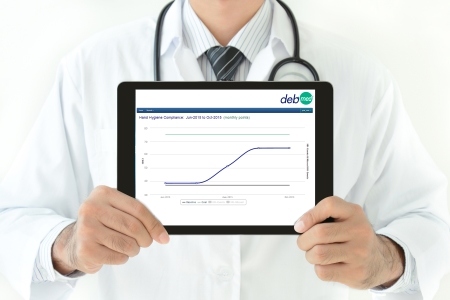Effective monitoring is an essential part of any hand hygiene regime. Here, Paul Jakeway looks at how common methods fall short, and why group monitoring is the way forward for the healthcare sector
Hand hygiene compliance is a major issue for hospitals.
The Department of Health estimates that roughly 300,000 patients develop a healthcare associated infection (HCAI) in England every year, with 5,000 of those cases proving fatal.
HCAIs cost the NHS around £1billion a year, and eight out of 10 infections are spread through contact with hands.
However, a third of people fail to wash their hands after visiting the bathroom – despite 95% of people saying they wash every time.
Effective monitoring is the answer to this, and is the key to improving hand hygiene compliance.
A group monitoring solution that promotes the spirit of collective responsibility among healthcare teams is ideal
The issue is that many monitoring methods can’t provide accurate or useful data and insight to work from.
Most commonly, ‘direct observation’ is used – human observers physically monitoring staff behaviour as they perform their day-to-day duties, and determining the healthcare facility’s compliance in line with the World Health Organization’s (WHO) Five Moments for Hand Hygiene.
Direct observation is strewn with limitations. Observational programmes are typically conducted manually, with limited sophistication in the gathering or analysis of the data compiled. And, with such obvious scrutiny, it is common for the ‘Hawthorne Effect’ to manifest itself, where medical staff are aware they are being watched, and exhibit different behaviour from normal.
As a result, compliance rates are artificially high, and not a true reflection of actual hand hygiene habits.

A third of people fail to wash their hands after visiting the bathroom, according to studies
There are several alternative monitoring options available to healthcare providers, but making the right decision on which to choose has a significant impact on its success – both in terms of hand hygiene compliance rates, as well as any financial implications in its installation and operating costs.
With many of the technological solutions now available on the market, however, there are still drawbacks that must be accounted for. Take video monitoring as an example – 24/7 surveillance exposes healthcare institutions to exactly the same pitfalls as traditional direct observation.
Having people trawl through hours of video footage from locations across a whole hospital site is costly, and practically impossible to keep track of effectively.
On this basis, a group monitoring solution that promotes the spirit of collective responsibility among healthcare teams is ideal.
This allows hospitals to keep track of hand hygiene events in real time and measure compliance rates against the WHO 5 Moments beyond just room entry and exit. It simply requires a non-intrusive system that does not disrupt workflow, but is sophisticated enough to gather genuinely-accurate data.
To make any hand hygiene compliance programme work effectively, healthcare institutions are recommended to improve the way they monitor the hand hygiene events and opportunities that occur in their facilities
The answer then, is electronic auditing – a cost-effective method that is considerably more reliable than direct monitoring. It captures 100% of hand hygiene events and uses a detailed algorithm to measure the result against the 5 Moments, providing operators with precise, quantified data that enables them to increase compliance. Just as importantly, the hospitals can implement such a system without causing any disruption to daily working practices.
Operators can access easy-to-digest web-based reports, giving them the insight to make informed decisions on how certain teams or departments can improve their compliance. Then, by clearly displaying hand hygiene trends and statistics for each hospital unit, staff can collaborate on compliance improvement plans, set goals and work as a team to do everything in their power to improve hand hygiene — reducing the instances of HCAIs.
To make any hand hygiene compliance programme work effectively, healthcare institutions are recommended to improve the way they monitor the hand hygiene events and opportunities that occur in their facilities. Group monitoring, backed up by an effective and accurate electronic data collection system, is the key to achieving this – and enhancing patient safety.

Hand hygiene compliancy tools help to monitor true figures in real time




